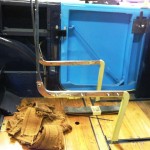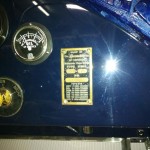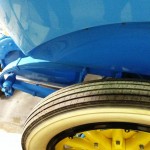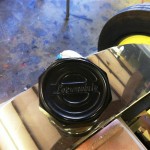A Locomobile??
The Locomobile Company of America was founded in 1899 manufacturing affordable steam powered cars in Watertown, Massachusetts. That lasted for a couple of years when they moved to Bridgeport, Connecticut and ditched the affordable cars for high-end luxury cars. When I mean luxury cars, I’m talking high-end. In 1919 a Locomobile open bodied car would sell for $10,000 while the proletarian Ford Model T sold for $300.
The pictures I am going to list here were taken at a local restoration shop. We know the owner, matter of fact I bought bowtie6‘s ECOTEC engine and gearbox from him. The Locomobile is there to have its upholstery completely restored including the enormous convertible top. Finding all the material for the restoration has been a painstaking process requiring a special run of material made by the original manufacturer. There will be no expense too high here…
There are so many details about this car. I spent quite a bit of time looking it over, taking pictures and wondering. Wondering where it had been, how many people it had carried and what roads and streets it had been driven on. The 1920’s were full of excesses before the stock market imploded. Wonder how many times this car was driven to swanky parties with occupants dressed to the hilt, “putting on the Ritz”? Makes you wonder…

Obviously, the body has been painted and a lot of work has been done to the engine. It is amazing. However, there are so many intricacies raging from the engine, the wheels, the interior, dash, engine (oh my!) and well… Let me show you.
The engine is a side valve, inline six. The piston jugs are finished in porcelain and each piston has 2 spark plugs. There is copper and brass galore. There is a magneto running power to each plug and each plug has a really interesting connector for the spark plug wire.
It looks like somebody must have spent a huge amount of time making the radiator. The thing looks handmade. The fan is pretty cool, with the outside ring around the blades. And take a look at that fan belt.
On the exhaust side of the engine you can see a chrome heat riser for the carbs. Down on the front side of the engine you can also see the water pump. On the intake side of the engine, right behind the horn you can see the magneto and the bundle of fabric-covered spark plug wires.
This is an intriguing detail:

On either side of the copper tubing you can see two “valve” looking affairs on the engine head. There were six of these, one for each cylinder. Since this is an engine that was also set up to start by hand (there was a hand crank extension sticking through the front of the rediator), these are pressure relief valves. Or, perhaps something to prime each cylinder with?
I’ll have more pics later…























































